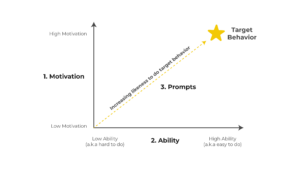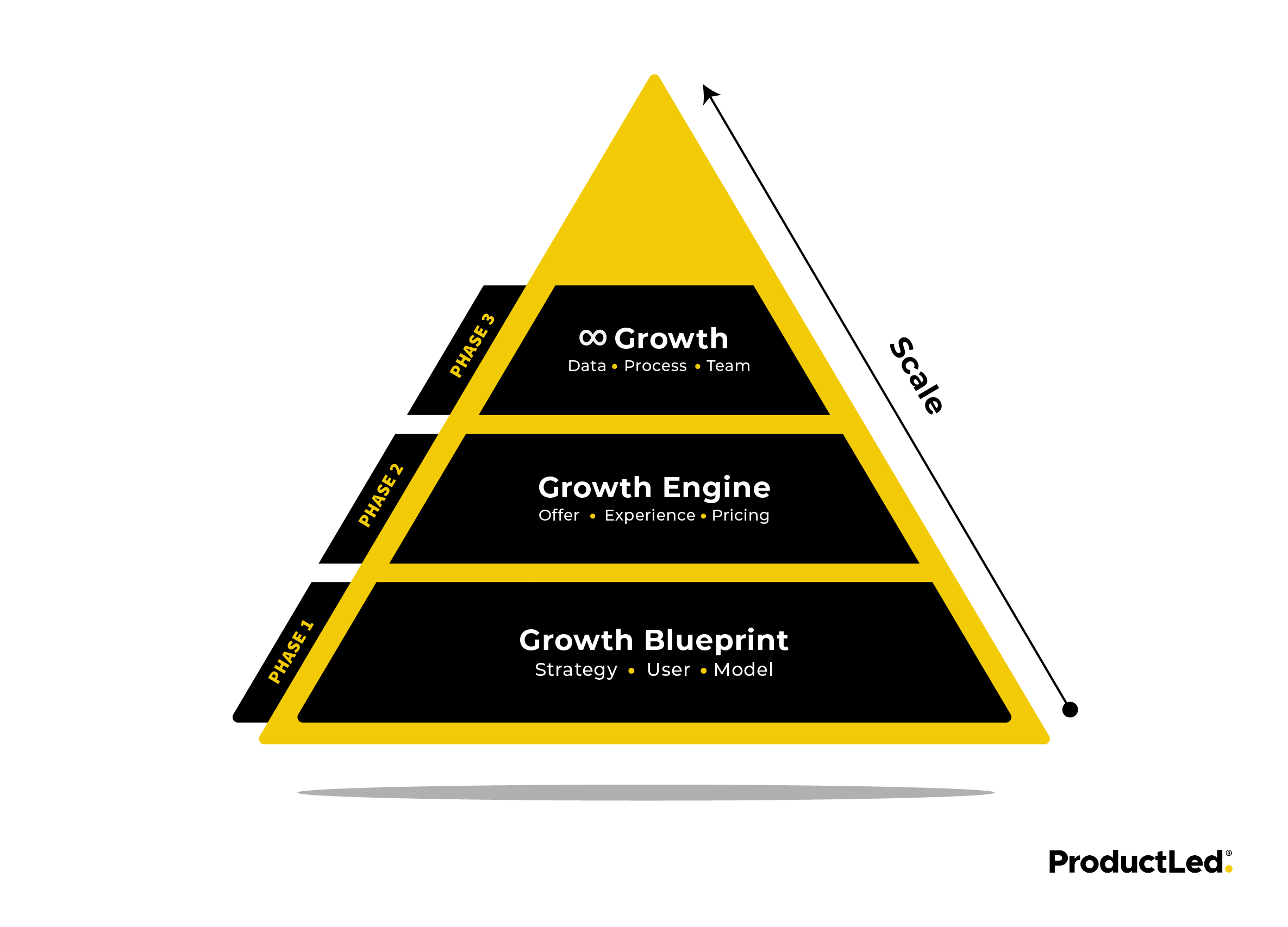Deciding whether to use a free trial, freemium experience, or demo model is one of the most important decisions you'll make when building a product-led business.
And you need to be extremely careful.
Choose the wrong model, and you'll likely see a low free-to-paid conversion rate.
Here's a story that shares why.
Back in 2016, when I worked at Vidyard, a video hosting company, the majority of our customers came through a sales-led motion.
We had a 30-day free trial where anyone could sign up for our product and test it out. In the free trial, users could sign up, poke around, and test out the tech, but it never really felt successful. Why?
Two reasons.
- We weren’t seeing a strong uptick of free trial users becoming paying customers.
- We were asking folks to do a lot. Uploading a video is a big ask.
Then, we launched a free Chrome extension where we made it incredibly easy to create and upload videos. Within the next year, this product acquired more than 100k users and has since been used by millions.
So how do you decide which one is right for your business? Unfortunately, you can’t just Google the pros and cons or ask a fellow SaaS founder which business model will work best for you.
Because that advice comes from people managing completely different businesses – different target audiences, different pricing strategies, and different products (which may range from “simple and familiar” to “how on earth do I even use this thing?”).
What works for them won’t necessarily work for you.
To make the right choice, you need a decision framework to decide on whether a free trial, freemium, or demo model will perform best for your business.
In the video and article below, I'll arm you with everything you need to know when making a decision between using a free trial or a freemium model.
I've also created this quiz that breaks down the main questions you need to ask yourself before deciding. It should provide you with some clarity that you're on the right path.
Now, aside from the quiz, let's get into the decision framework that will help make your decision a whole lot easier.
Meet the MOAT framework below:
- Market Strategy: Is your go-to-market strategy dominant, discrete, or differentiated?
- Ocean Conditions: Are you in a red or blue ocean business?
- Audience: Do you have a top-down or bottom-up marketing strategy?
- Time-to-value: How motivated and tech-savvy is your audience?
Let’s quickly go over the difference between a free trial and a freemium model, so we’re on the same page.
What’s the difference between a free trial and a freemium model?
By definition, a free trial is a customer acquisition model that provides a partial or complete product to prospects free of charge for a limited time.
A freemium model is a customer acquisition model that provides access to part of a software product to prospects free of charge, without a time limit.
Now, it might seem like freemium is just an indefinite free trial, but the go-to-market strategies could not be more different.
See for yourself below.
Market Strategy: Is your growth strategy dominant, discrete, or differentiated?
A free trial or freemium model isn't the only go-to-market approach. In Tony Ulwick’s job-to-be-done growth matrix, he broke down the five most common growth strategies for any business.
However, I’m going to highlight only the differentiated, dominant, and disruptive strategies. They work best in the SaaS space, especially if you want to grow quickly.
As you can see in the graph below, these three growth strategies each have a unique advantage:
Dominant growth strategy
The dominant growth strategy works great if you do something much better than your market and can charge significantly less.
Companies that employ the dominant growth strategy include:
- Netflix
- Uber
- Shopify
The freemium model is vital in a dominant growth strategy and can help you take a sizable chunk out of a market.
How big is the market? Well, Jason Benkins, the founder of SaaStr, argues in this article that you need 50 million active users for freemium to work.
Now, I’d argue that you don’t need 50 million active users for freemium to work, but you do need a significant volume of users signing up for the math to work in your favor.
If you have a niche product with a total addressable market (TAM) of 50 customers, good luck. A freemium model will give away your product to the precious few users who might actually pay for it.
The verdict: Both freemium and free-trial models work much better than the traditional sales model (i.e., demo requests) in the dominant growth strategy because you keep costs low and prevent competitors from stealing your market share. That’s your competitive advantage: low cost for an exceptional product.
Questions to ask yourself when deciding if a dominant growth strategy is right for you:
- Is your TAM big enough to support a freemium model?
- Does your product solve a specific job significantly better and at a lower cost than anyone else in the market?
- Can your user realize significant ongoing value quickly with little-to-no help from company personnel?
- Do you want to be the undisputed market leader in your category?
Differentiated SaaS growth strategy
This is a common strategy if you want to pick (and win) your fight with an industry goliath.
Your main line of defense against the Goliath in your market is specialization. For instance, if you were to hypothetically take away part of HubSpot’s market share, you might discover an underserved niche (e.g., real estate agents) and create a CRM product tailored to that audience.
Differentiated growth requires you to do a specific job better than the competition and charge significantly more. This is not a one-size-fits-all model.
This approach works well with free trials and demos. However, due to the inherent specialization and complexity of these products, it’s difficult to create a freemium experience with an “Aha!” moment.
The verdict: Both free trials and demos work great with a differentiated approach, but due to the market-size limitations and complexity of the product, a freemium model will not work in this environment. Your competitive advantage is how you solve your customer’s problems.
Questions to ask yourself when deciding if a differentiated growth strategy is right for you:
- Is your market comprised of underserved customers?
- What is your TAM?
- Is your Annual Contract Value (ACV) high enough to support a low- or high-touch sales team?
- Could your prospects experience an “Aha!” moment during a free trial?
Disruptive SaaS growth strategy
Most fast-growing SaaS companies are labeled “disruptors,” but don’t let the label fool you. Few ever deploy a disruptive growth strategy.
Why?
The disruptive growth approach requires you to charge less for what many might consider an “inferior product.” Most people think this is a bad idea, but it’s really not.
If you’ve used Canva, a simple custom-graphic tool creator, you’ve witnessed this firsthand. If you compare Adobe Photoshop’s features against those of Canva, Canva loses every time (by a lot).
But with so many over-served customers in this particular market, Canva was able to build a much simpler product that solved very specific pain points, such as creating social media graphics in seconds.
Quite a few other companies have taken this approach:
- Google Docs (relative to Microsoft Office)
- Udacity (relative to traditional universities)
- Wave (relative to accounting software)
The verdict: The freemium model thrives in a disruptive environment. Keeping costs low draws in prospects using existing solutions. Since the product is a scaled-down version of an existing solution, it must be easy to use. You can use a free trial with a disruptive growth strategy, but it weakens the “magnetic draw” enjoyed by the freemium model.
Questions to ask yourself when deciding if a disruptive growth strategy is right for you:
- Is your market full of over-served customers? Are you competing in a red ocean?
- Is your market large enough to support a freemium model? (Hint: Look to your competitors to gauge the market size.)
- Do you have the resources to support a freemium model?
- Can your user onboarding be completely self-service?
Activity: Decide on your growth strategy
By now, I want you to decide whether your SaaS product follows a dominant, differentiated, or disruptive growth strategy.
Questions to ask yourself when deciding on your market strategy:
- Do you want to offer the best solution for the lowest price? (Dominant strategy)
- Do you want to offer the best-customized solution for the highest price to underserved customers? (Differentiated strategy)
- Do you want to offer the simplest product for the lowest price to over-served customers? (Disruptive strategy)
Once you know your go-to-market strategy, it will become much easier to decide between a free trial, freemium, or demo model for your business.
Ocean Conditions: Are you in a red or blue ocean business?
If you’re not familiar with the Blue Ocean strategy, here’s the difference between blue- and red-ocean businesses, according to Blue Ocean Strategy Australia:
Red Ocean companies try to outperform their rivals to grab a greater share of existing demand. As the market space gets crowded, prospects for profits and growth reduce. Products become commodities, and cut-throat competition turns the ocean bloody red.
Blue Ocean companies, in contrast, access untapped market space and create demand, and so they have the opportunity for highly profitable growth. In Blue Oceans, competition is irrelevant. Yes, imitators arise, but experience shows there is a wide window of opportunity to stay ahead of imitators.
To put it simply, if you’re competing in a red ocean, you’re fighting to capture existing demand, whereas, in a blue ocean, you’re creating demand.
Why does this matter?
If you’re creating demand, there’s often a heavy learning curve - you need to educate your market on why your new way of doing something is better.
If you start in a blue ocean with a completely no-touch, self-service model, people won’t understand how your product helps them. It will probably fail.
In a red ocean, prospects already know how your product can help them, and a self-service model is advantageous - it can widen your funnel, decrease your CAC, and help you expand globally in a fraction of the time.
This trend - though not a rule - is common among the hundreds of B2B SaaS businesses I’ve analyzed:
- Blue Ocean businesses typically lead with a Sales or Marketing-Led GTM.
- Red Ocean businesses typically lead with a Product-Led GTM.
Take live-chat software as an example: When it first came to market, most companies started with traditional sales- and marketing-led GTM strategies. After the category matured, however, it became almost impossible to find a live chat application without a self-service model.
For example, when we first launched an event app in 2010, no one knew they wanted it - a self-serve product didn't make sense. Fast forward to 2018, and self-serve is now a valid GTM strategy, though customers still expect heavy service support.
If we had launched self-serve back then, we would've failed. In my opinion, self-serve is the only distribution worth undertaking once the market is mature. – Pankaj, CEO of Talkable
Questions to ask yourself when deciding between a blue or red ocean:
- Am I creating or capturing existing demand?
- Am I competing in a red or blue ocean?
Note: If you are operating in a blue ocean, that doesn’t necessarily rule out a self-service model. However, you need to ask yourself “when,” not “if,” you’re going to launch a self-service arm of the business.
Audience: Do you have a top-down or bottom-up marketing strategy?
The very nature of being a product-led business means that you’re likely to attract a particular crowd: Makers.
Makers are people who try before they buy. They want to understand what a product is really about and how it can solve their problems. Often, makers are individual contributors to a business. They execute the business strategy. They are doers.
On the other side of the spectrum are shakers.
Shakers are members of high-level management (i.e., C-Suite) with the right to “shake” the business or their team by mutual consent or if need be, vested authority.
Regardless of size, most companies (including your competitors’) target the shakers because they are the decision-makers. This is known as a top-down marketing approach.
As a result, shakers are often inundated with countless sales emails and privy to demo requests. They need to see the big picture of how a new software tool can grow the business - they won’t be there to use the software daily.
Why is this important?
Because if you pair a top-down marketing approach with a self-service model, your demo requests will outperform the self-service arm of the business. This outcome is true even with a top-performing free-trial or freemium model. Your marketing approach needs to sync with your self-service model.
Now, can you combine a bottom-up and top-down marketing approach? Absolutely.
Previously, at Vidyard, we launched a freemium product known as GoVideo while keeping the main arm of the business, a top-down marketing approach.
If you target shakers, it’s hard to lead with a free trial or freemium model because your audience isn’t the end-user, and they won’t have the technical chops to grasp the full value of your product.
If you target makers, leading with a free trial or freemium model may work really well. These are end-users who can experience the core value of your product and make a convincing case to shakers.
Generally, a top-down marketing approach works well with a sales- or marketing-led GTM, while a bottom-up approach works best with a product-led approach.
Questions to ask yourself when deciding between a top-down or bottom-up marketing approach:
- Are you currently targeting makers or shakers?
- What is your ACV for each customer? Is it high enough to justify a low- or high-touch sales model?
Unfortunately, none of this matters unless your potential customer is motivated to buy.
Time-to-Talue: How motivated and tech-savvy is your audience?
To create a successful product-led business, you need a quick time-to-value, which will increase product adoption and activation rates.
You need to fight to control of these three factors:
- Motivation
- Ability
- Triggers
To break this down into a science, BJ Fogg from Stanford University did an incredible study that gives us a model to reduce the time-to-value in any product through motivation, ability, and triggers.
The Fogg model below helps us understand the four business scenarios that affect whether people adopt a new target behavior in a product.
This graph has four common scenarios shared by all SaaS products:
- Scenario #1: Mission Impossible -- Your user has low motivation and low ability. Sorry, but you will never help your users tackle a new behavior.
- Scenario #2: Rookie -- Your user has high motivation and low ability. You can afford to have a terrible user experience (like IBM SPSS) and still get people to change. Not ideal, but not the worst outcome either. People who are in this stage could include: employees who are forced to use your software,
- Scenario #3: Veteran -- Your user has low motivation and high ability. This means your user will accomplish the target behavior easily but could flee at any sign of friction—or hunger. Who knows?!
- Scenario #4: Spoiled -- This is the outcome to optimize for. Your user has high motivation and high ability. This means that you’ll be able to help the greatest amount of people in your Total Addressable Market (TAM).
I’m curious. What scenario resembles your business?
If your user has low motivation and equally low ability, your adoption rates will be quite sad.
If you’re solving a small pain point (e.g., social media scheduling) in which the motivation to use the product is low, make sure that your product is extremely easy to use.
Now, just because you think your product is easy to use, it doesn’t mean your target audience thinks the same way.
For instance, give the same accounting software to Sam, the concrete guy, and Janice, the AI researcher, and you’ll get two very different outcomes. One can’t figure out how to log in, and the other masters your product in 5 minutes.
How to decrease time-to-value beyond the Fogg model
Reduce friction. While we can try to motivate users, it's often easier and more cost-effective to optimize your self-service experience.
Any product that significantly reduces the time-to-value and steps to complete a task will enjoy high adoption rates. In other words, Amazon’s One-Click Buy Button.
This sounds obvious, but many companies unknowingly add friction to a buying process by doing things like:
- Not showing pricing on the website.
- Creating a lengthy process to activate a new user’s account.
- Asking for 10 different fields to sign up for an account.
Those are just a few examples.
Questions to help narrow down which option is best for you:
- How motivated are your users when they sign up for your product?
- Is your product easy for your target audience to use?
- If not, what can you do to make it easier? Streamlined user onboarding by Appcues? In-app messaging? You get the point.
- Are people able to experience the core value of the product without any hand-holding?
Can you have a hybrid strategy?
Absolutely. There are several common ways to employ a hybrid strategy for your SaaS business.
Example #1: Launch a new product
When you’re an established business and want to de-risk your business, launching a new self-service product might be a solid option.
This allows you to experiment with a product to see if the model will work for your business.
It’s a strategy that has been one of the most effective to date. At Vidyard, we tested this strategy by launching GoVideo and refining our freemium go-to-market strategy. It was far from perfect when we launched, but we were able to improve it and acquire 100,000s of new users in the process.
This, in turn, helped the business prove that the model was effective and build a small in-house team that knew how to bring a self-service product to market.
Example #2: Go freemium, with a trial
If you have a product with lots of features, this strategy can work great. As long as your freemium version is valuable, you can layer on free-trial upgrades within the freemium product.
HubSpot has been doing this successfully for a while now. When you sign up for the free marketing and sales tools, you get immediate value from the product. But, as you get more value from the free product, they tempt you with free-trial landing pages for blocked features. This is great because it allows the user to experience the new feature for a limited amount of time before upgrading.
For HubSpot’s sales team, it’s also convenient: It acts as a “hand raiser” to cue them to reach out to each Product Qualified Lead and ensure they succeed with the new feature(s).
Example #3: Go free trial, follow with freemium
If you don’t convert at the end of Nudge.ai’s 30-day free trial, you’re prompted to use their free tool. This freemium product sits in Gmail and gives you information on each lead in your inbox. In addition to providing value, it’s an inexpensive form of advertising and keeping their solution top-of-mind.
There are other ways you can slice and dice hybrid models, too, but these three are the most common.
Putting everything together
When deciding the best way to grow your SaaS business, it’s important to refine your growth strategy.
If your product does something much better than your market and you charge significantly less, a dominant growth strategy might be a good fit for you.
Both freemium and free trial models support the dominant growth strategy exceptionally well; both are cost-effective customer acquisition models.
However, if you know there’s a well-defined need that’s being addressed poorly, a differentiated approach might work well for you. Differentiated growth requires you to do a job better than the competition and charge significantly more. This is not a one-size-fits-all model.
Both free trials and demos work great with a differentiated approach, but due to market-size limitations, a freemium model is unlikely to work in this environment.
In contrast, the disruptive growth approach requires you to sell an “inferior” product for less. If you have a simpler solution than your competitors, the freemium model thrives in the disruptive environment - it keeps costs low to increase the magnetic draw for prospects using existing solutions. Plus, it’s easy for your prospects to learn how to use your product (at least should be).
Accelerate scalable growth with expert guidance on your product-led model
Choosing the right free experience is just one key element of building a successful product-led business. You also need to create an unshakeable foundation. Without it, product-led initiatives are often doomed from the start.
At ProductLed Academy, we guide B2B SaaS founders through a three-phase system to achieve predictable scaling for your business. Identifying and fine-tuning the best product-led model for your users is one of nine core components we help SaaS teams work through in our coaching program.
There's a lot more to PLG success than picking between a freemium or free trial model.
Read more about the ProductLed System here.
During the coaching program, you'll work directly with Wes Bush to master each of these nine components of a successful product-led business:
- Vision: What is your company really good at?
- User: Who do you serve best?
- Model: How do you create a ton of value for your users to win?
- Offer: Have you crafted an irresistible free offer for your ideal users?
- Experience: Have you created an effortless path to value for your users?
- Pricing: Is it easy for users to upgrade without talking to anyone?
- Data: Do you know where users are getting stuck in your product?
- Process: Do you have a growth process that enables your team to build out experiments, prioritize the high-impact ones, and launch the ones that are easiest?
- Team: Is your team full of A players capable of taking you to the next level?
While you can have one or more of these dialed in perfectly, if you’re missing one of these key players, you’re going to have a hard time with growth.
If you're ready to break through to the next level and master your pricing strategy, be sure to check out ProductLed Academy.
Freemium and Free Trial FAQ
1. What are the different types of freemium?
There are actually several different types of freemium, including more diverse freemium models that charge for more premium features like add-ons, extensions, more functionality, support, integration, and customizations instead of offering more of what the user already gets for free.
2. Is freemium a viable pricing strategy?
Freemium is considered more of a marketing strategy, not a revenue model. It is used in the hopes that the value the user can find in the premium tier is going to entice prospective customers to upgrade to the paid version. Basically, if the customer wants to use your product or service, then they must pay.
You can either choose to offer a free trial for a specific amount of time or offer the entire product or service for free while also selling other premium features like upgrades and add-ons.
3. Are free trials really free?
Free trials are offered to customers for free for a short period, so they can try it out. So, yes, it is free. However, most free trials require you to cancel before the free trial is up or the credit card you put on file will be charged for the use of the product or service.
4. What are the tradeoffs between freemium models and free trials for SaaS startups?
Freemium is a customer acquisition model providing access to some of a product to a potential customer for free without a time limit. A free trial, on the other hand, is a customer acquisition model providing a partial or complete product to a potential customer for free for only a limited amount of time.
Either way, the customer will need to spend time learning how the product works while also trusting that it can handle particular tasks. So, if the product fails to perform as advertised, you will be wasting your time and energy on something that won't work for you.
5. How do you convert freemium to paid?
To convert freemium customers to paid customers, you need to find the right balance between value and comfortability. You also need to limit plan features and promote them inside of the product, limit your free plan by quantity instead of features, and find out exactly what you should be limiting by talking to your customers.
6. What techniques can be used to encourage free trial customers to convert?
When trying to get free trial customers to convert to paying customers, you need to make it easy for people to use your product. You also need to understand which premium features are the most valuable to users, create a sense of urgency, and provide personalized demos. Additionally, you can also ask for payment information to start a trial and then send an end-of-trial email.
7. Do free trials increase sales?
When it comes to free trials for an online business, it can get to be tricky. Typically, online services have a recurring payment system, so they have the best chance of converting free trials to sales. So, a business can offer free trials for new users and get a higher sale conversion rate out of it.
8. How do you market to customers when a free trial is over?
To get those free trial customers when the free trial is over, offer the trial without asking for credit card information. You should also use email, remind them when the free trial is about to expire, provide an early discount if they purchase before the expiration, all them to extend their free trial and make it easier for the customer to go through and make the purchase.
Deciding what free model is best for your SaaS company
Free trial or freemium?
This might shock you but…
It doesn’t matter!
What really matters is how well you understand your ideal users.
The best product-led models give users everything they need to succeed at each stage of their journey.
But reaching this point is hard because your model touches every part of business, including:
- Acquisition: The features you offer for free are fundamental to the commitments you make to users when they sign up.
- Engagement: You're making critical choices about which user challenges to address for free and which ones to monetize.
- Monetization: Decisions about what to offer at no cost versus what to charge for are crucial.
If you want to ensure that your free offer provides users with everything they need to find value, be sure to check out the ProductLed coaching program.












